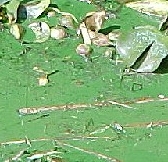HISTORY OF TOXIC CYANOBACTERIA IN SOUTH AFRICA
The existence of toxic cyanobacteria is neither new nor localised
nor restricted to South Africa.
The first known case of livestock poisoning in South Africa
dates back to the 1920s.
Since then, incidents have occurred at Vaal Dam, Witbank Dam,
Erfenis Dam, Bospoort Dam and Roodeplaat Dam. Smaller farm dams have
also had incidents of toxic cyanobacteria.

|
WHAT IS BEING DONE TO MANAGE THE SITUATION
IN SOUTH AFRICA?
- Department of Water and Sanitation is conducting situation-
specific surveillance
- The Toxic Algae Forum, established in 1998, promotes awareness
of the causes and consequences of cyanobacterial toxins
- Department of Water and Sanitation requests that authorities
controlling public access to dams put up notices cautioning the public
against contact with scums
REMEMBER
- For your own safety regard all cyanobacterial or blue-green algal blooms
in South Africa as potentially toxic
- Report incidents of green scums to the
Department of Water and Sanitation
24-hour pollution hotline
FURTHER INFORMATION
- For copies of the Toxic Algae (cyanobacteria) pamphlet containing the information
given here, please write to:
The Department of Water and Sanitation
Private Bag X313
PRETORIA 0001 (South Africa)
or try the E-mail address at the bottom of this page.
- For further information contact:
The Director, Resource Quality Information Services
Department of Water and Sanitation
Private Bag X313
PRETORIA 0001 (South Africa)
<-Back|
Toxic Cyanobacterial main page
Please send comments on these pages to
the webmaster
at the Resource Quality Information Services Directorate.
Last update
2015-08-13 11:57
|
